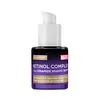What's inside
What's inside
 Key Ingredients
Key Ingredients

 Benefits
Benefits

 Concerns
Concerns

 Ingredients Side-by-side
Ingredients Side-by-side

Water
Skin ConditioningButylene Glycol
HumectantNiacinamide
SmoothingTranexamic Acid
AstringentDimethylmethoxy Chromanyl Palmitate
Skin ConditioningGlycyrrhiza Glabra Root Extract
BleachingAloe Barbadensis Leaf Juice
Skin ConditioningGlycerin
Humectant3-O-Ethyl Ascorbic Acid
Skin ConditioningSodium Hyaluronate
HumectantPanthenol
Skin ConditioningSodium PCA
HumectantAllantoin
Skin ConditioningDipotassium Glycyrrhizate
HumectantPolyacrylate Crosspolymer-6
Emulsion StabilisingXanthan Gum
EmulsifyingTocopheryl Acetate
AntioxidantSodium Hydrosulfite
Tetrasodium EDTA
Phenoxyethanol
PreservativeWater, Butylene Glycol, Niacinamide, Tranexamic Acid, Dimethylmethoxy Chromanyl Palmitate, Glycyrrhiza Glabra Root Extract, Aloe Barbadensis Leaf Juice, Glycerin, 3-O-Ethyl Ascorbic Acid, Sodium Hyaluronate, Panthenol, Sodium PCA, Allantoin, Dipotassium Glycyrrhizate, Polyacrylate Crosspolymer-6, Xanthan Gum, Tocopheryl Acetate, Sodium Hydrosulfite, Tetrasodium EDTA, Phenoxyethanol
Water
Skin ConditioningGlycerin
HumectantRetinol
Skin ConditioningDimethyl Isosorbide
SolventChlorphenesin
AntimicrobialSqualane
EmollientCeteareth-25
CleansingHydroxypinacolone Retinoate
Skin ConditioningCetyl Alcohol
EmollientPolyacrylate Crosspolymer-6
Emulsion StabilisingBehenic Acid
CleansingCholesterol
EmollientCeramide NP
Skin ConditioningCeramide Ns
Skin ConditioningCeramide Eos
Skin ConditioningCeramide EOP
Skin ConditioningCeramide AP
Skin ConditioningCaprooyl Phytosphingosine
Skin ConditioningCaprooyl Sphingosine
Skin ConditioningMannitol
HumectantPhosphatidylcholine
EmulsifyingRetinal
Skin ConditioningPotassium Sorbate
PreservativeSodium Benzoate
MaskingCitric Acid
BufferingSodium Chloride
MaskingWater, Glycerin, Retinol, Dimethyl Isosorbide, Chlorphenesin, Squalane, Ceteareth-25, Hydroxypinacolone Retinoate, Cetyl Alcohol, Polyacrylate Crosspolymer-6, Behenic Acid, Cholesterol, Ceramide NP, Ceramide Ns, Ceramide Eos, Ceramide EOP, Ceramide AP, Caprooyl Phytosphingosine, Caprooyl Sphingosine, Mannitol, Phosphatidylcholine, Retinal, Potassium Sorbate, Sodium Benzoate, Citric Acid, Sodium Chloride
Ingredients Explained
These ingredients are found in both products.
Ingredients higher up in an ingredient list are typically present in a larger amount.
Glycerin is already naturally found in your skin. It helps moisturize and protect your skin.
A study from 2016 found glycerin to be more effective as a humectant than AHAs and hyaluronic acid.
As a humectant, it helps the skin stay hydrated by pulling moisture to your skin. The low molecular weight of glycerin allows it to pull moisture into the deeper layers of your skin.
Hydrated skin improves your skin barrier; Your skin barrier helps protect against irritants and bacteria.
Glycerin has also been found to have antimicrobial and antiviral properties. Due to these properties, glycerin is often used in wound and burn treatments.
In cosmetics, glycerin is usually derived from plants such as soybean or palm. However, it can also be sourced from animals, such as tallow or animal fat.
This ingredient is organic, colorless, odorless, and non-toxic.
Glycerin is the name for this ingredient in American English. British English uses Glycerol/Glycerine.
Learn more about GlycerinPolyacrylate Crosspolymer-6 is a texture enhancer and pH adjuster.
It is be used to thicken water-based products and create a gel-texture with a velvet feel.
One manufacturer claims this ingredient to have a pH range of 2-8 and to be biodegradable.
Learn more about Polyacrylate Crosspolymer-6Water. It's the most common cosmetic ingredient of all. You'll usually see it at the top of ingredient lists, meaning that it makes up the largest part of the product.
So why is it so popular? Water most often acts as a solvent - this means that it helps dissolve other ingredients into the formulation.
You'll also recognize water as that liquid we all need to stay alive. If you see this, drink a glass of water. Stay hydrated!
Learn more about Water